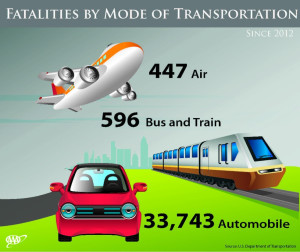 Most of us have heard that it’s safer to fly in a commercial aircraft than ride in a vehicle. This may be true, but what about other modes of transportation? AAA recently analyzed data from the U.S. Department of Transportation to answer this question.
Most of us have heard that it’s safer to fly in a commercial aircraft than ride in a vehicle. This may be true, but what about other modes of transportation? AAA recently analyzed data from the U.S. Department of Transportation to answer this question.
“Fatality rates across all modes of transportation have fallen considerably in recent decades,” said Tracy Noble, Manager of Public and Government Affairs for AAA Mid-Atlantic. “Yet it remains an issue that affects everyone — whether as victims, family members or travelers affected by delays or road closures.”
In 2012, the total number of deaths for all land, sea and air transportation crashes in the United States was 35,594. This represents a drop of about 25 percent from 1990, when a total of 47,379 deaths occurred.
The U.S. Department of Transportation listed fatalities by mode of transportation in 2012. As a safety advocate, AAA breaks down these figures:
Bus (39 deaths): School buses and city buses generally provide very safe transportation. In recent years, intercity bus travel has been affected sometimes negatively by a number of discount operators. The Federal Motor Carrier Safety Administration has shut down several lines due to safety issues.
Aviation (447 deaths): U.S. commercial planes still are the safest way to travel. Most deaths occur to people riding in small planes. Private planes also cause far more deaths than commercial airlines, but those deaths are not included in this statistic.
Rail (557 deaths): American passenger railroads, dominated by Amtrak, deliver a lower standard of service than other railroads around the world. This statistic is deceptive because it includes more than passengers – lives lost include people at rail yards, people on the tracks, accidents at crossings and suicides.
Highway (33,743 deaths): While fewer motorists are dying from car crashes because of improved safety technologies, a car is still the deadliest way to travel. The decrease in deaths is partly because of improved safety technologies and changing trends in driving, such as a decrease in fatalities from drinking and driving. Crashes caused by distracted drivers, however, have grown enormously. In fact, distracted drivers cause more fatal crashes in all modes of transportation combined.
When there is a crash with mass transit, such as a plane, train, bus or limousine, the National Transportation Safety Board investigates the disaster and offers safety recommendations, such as having child safety seats on planes and making collision avoidance systems standard on all new passenger and commercial vehicles.
“Sadly, the NTSB recommendations often don’t get beyond being just that — recommendations,” Noble said. “As a safety advocate, AAA urges our leaders to heed the recommendations of the NTSB and make transportation safety a priority.”
[TLS]


Millions of people drive every day. Thousands fly and use Public trans. every day.
How can we decide what is safe based on fatalities without first the amount of users and distance traveled?